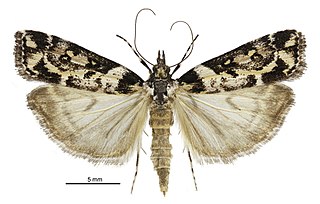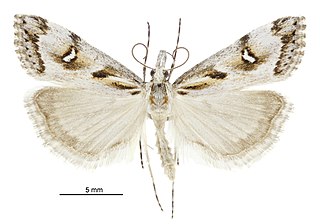
Lichenaula lichenea is a species of moth of the family Xyloryctidae. It is known in Australia from the Australian Capital Territory, New South Wales and Queensland.

Eudonia diphtheralis is a species of moth in the family Crambidae. It is endemic to New Zealand.

Glaucocharis chrysochyta is a species of moth in the family Crambidae. This species was first described by Edward Meyrick in 1882. It is endemic to New Zealand and is found throughout the country. It inhabits native forest. Larvae appear to feed on moss and likely pupate there. Adult moths are on the wing from November to March. They fly at night and are attracted to light.

Gadira leucophthalma, the beaked moss moth, is a moth in the family Crambidae. It is endemic to New Zealand. It is found in the south eastern side of the South Island down to Banks Peninsula. G. leucophthalma inhabits the foredunes of coastal areas. The larval host is unknown but it has been hypothesised that the larvae feed on moss. The adult moths are day flying although some specimens have been trapped at night via light traps. Adults are commonly on the wing from March to April. This species has been classified as Nationally Vulnerable by the Department of Conservation.

Glaucocharis pyrsophanes is a moth in the family Crambidae. It was described by Edward Meyrick in 1882. It is endemic to New Zealand.
Euchaetis endoleuca is a moth in the family Oecophoridae. It was described by Edward Meyrick in 1888. It is found in Australia, where it has been recorded from South Australia and Western Australia.
Garrha costimacula is a moth in the family Oecophoridae. It was described by Edward Meyrick in 1883. It is found in Australia, where it has been recorded from Queensland and New South Wales.
Symmetrischema loquax is a moth in the family Gelechiidae. It was described by Edward Meyrick in 1917. It is found in Peru.
Commatica lupata is a moth in the family Gelechiidae. It was described by Edward Meyrick in 1914. It is found in Guyana and Peru.
Parapsectris ferax is a moth in the family Gelechiidae. It was described by Edward Meyrick in 1913. It is found in Mpumalanga, South Africa.
Idiophantis anisosticta is a moth of the family Gelechiidae. It was described by Edward Meyrick in 1916. It is found in Sri Lanka and Myanmar.
Aristotelia thalamitis is a moth of the family Gelechiidae. It was described by Edward Meyrick in 1908. It is found in Assam, India.
Enchocrates phaedryntis is a moth in the family Depressariidae. It was described by Edward Meyrick in 1888. It is found in Australia, where it has been recorded from Western Australia.
Antaeotricha encyclia is a species of moth in the family Depressariidae. It was described by Edward Meyrick in 1915. It is found in Colombia.
Imma auxobathra is a moth in the family Immidae. It was described by Edward Meyrick in 1906. It is found on Borneo and in Nepal.
Imma ancistrota is a moth in the family Immidae. It was described by Edward Meyrick in 1912. It is found on New Guinea.
Imma halonitis is a moth in the family Immidae. It was described by Edward Meyrick in 1920. It is found in Chennai, India.
Moca aphrodora is a species of moth in the family Immidae first described by Edward Meyrick in 1922. It is found in Brazil and Peru.
Imma eriospila is a species of moth in the family Immidae. It was described by Edward Meyrick in 1922. It is found in Pará, Brazil.

Tingena hemimochla is a species of moth in the family Oecophoridae. It is endemic to New Zealand and has been observed in the North Island. Adults of this species are on the wing from December until March.





